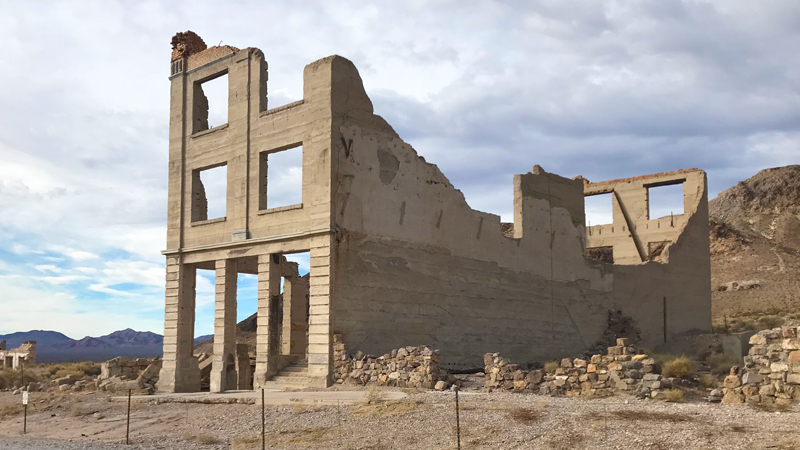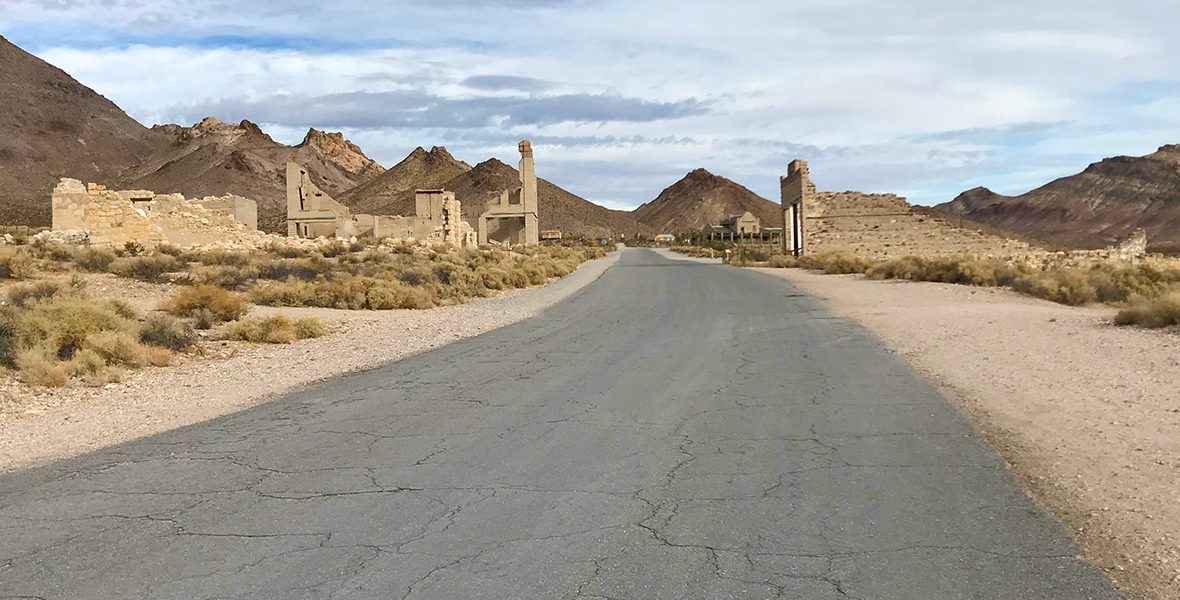
Our last day of adventuring in Death Valley was Thanksgiving Day and we were all exhausted from four straight days of hiking and adventuring in the hot desert and looking forward to a day of exploring with very little hiking! Even in late November, it was in the high 70s-80s with almost zero humidity, so it was very hot on the Death Valley floor and very cold up high in the mountains!
- On our first day in the park, we visited Rainbow Canyon and Father Crowley Vista, hiked to Darwin Falls, stopped in Panamint Springs, and drove out the Wildrose Charcoal Kilns.
- On our second day in Death Valley, we drove out to Aguereberry Point and hiked the mountaintop trail, explored the Eureka Mine, Cashier Mill and Aguereberry Camp ruins, hiked the Mosaic Canyon Trail, and played in the Mesquite Flat Sand Dunes.
- On our third day, we walked the Salt Creek Trail and the Harmony Borax Works Trail, visited the Borax Museum in Furnace Creek, drove through the one-way Mustard Canyon, hiked the Keane Wonder Mine, visited Zabriskie Point, drove through and hiked in Twenty Mule Team Canyon, and enjoyed an LTE signal at Dante’s View.
- On our fourth day in Death Valley, we hiked the Golden Canyon Trail, visited Devil’s Golf Course and the Badwater Salt Flats, walked the Natural Bridge Canyon Trail, drove Artist’s Drive to Artist’s Palette, and we drove went back to Twenty Mule Team Canyon for some more hiking and Dante’s View for sunset.
- Our fifth and last day in Death Valley began with a visit to the Goldwell Open Air Museum and the Rhyolite Ghost Town outside the park boundaries in Nevada. We then drove the 27 mile Titus Canyon Road and visited the Leadfield Ghost Town, and finished up the day at Ubehebe Crater for one last amazing sunset.
Thankfully, we basically got to do almost everything I wanted to do in Death Valley National Park, including the Ghost Town of Rhyolite, in five days. The only things we didn’t get to do were touring Scotty’s Castle (closed because of storm damage), visiting the Eureka Dunes (too far out of the away), and checking out the Racetrack Playa (requires special heavy-duty tires). I did try to convince Brian to drive the very rugged road out to the playa anyway, but he refused, and thank goodness he did. We came across another family who tried it in their truck and sliced a tire right open!

Visiting The Rhyolite Ghost Town
Sitting between Death Valley National Park, California and Beatty, Nevada, Rhyolite is one of the most photographed ghost towns in the west.
At one time Rhyolite was a thriving gold mining boom town, with hotels, stores, saloons, barber shops, a school, a bank, an opera house, a jail, an ice plant, a jewelry store, two electric plants, foundries and machine shops, a hospital, and more. But all that remains now are crumbling buildings, old foundations, and a cemetery. Today you can see walls of the three story bank building, part of the old jail, remains of the two story school, crumbing remains of other buildings, and an old caboose which was used as a gas station. The privately-owned train depot and Kelly Bottle House are the only two complete buildings left standing.
Our first stop was the Kelly Bottle House — an entire house made from discarded glass bottles that weren’t even washed first because water was such a precious commodity! The house is closed to the public and you can no longer go inside, but we got to explore the outside a bit. We then parked along the side of the road near the first building ruins so we could walk through the ghost town and explore the buildings. It was still early enough in the day that we there were only a few other people in the entire area, so the eerie, old, abandoned ghost town feeling was in full effect… we even saw a few tumbleweeds blow across the road!
We walked through ruins of:
- The Overbury Building and Bishop Jewelry Store
- The three-story John S Cook & Co. Bank
- The HD & LD Porter building
- The two-story school house
- And a small wooden house
We also got to see the jail standing far off by itself, the old gas station caboose, and the original train depot building that was later a casio and then a museum — and if you look closely at the surrounding mountains, you can even see abandoned mine entrances dotting the hills. When were done checking out the ghost town, we hopped back in the truck for a short stop at the small Rhyolite-Bullfrog Cemetery before beginning out Titus Canyon Adventure.
History Of Rhyolite, Nevada
In 1904, prospectors Shorty Harris and E. L. Cross found quartz all over a hill and according to Shorty, “…the quartz was just full of free gold.” While the only other person living in the area at the time was Old Man Beatty who lived in a ranch with his family five miles away, Harris predicted that this district was going to be the banner camp of Nevada — and he was right! The area was named the Bullfrog Mining District because Harris and Cross thought the greenish-colored mountains dotted with yellow metal looked like the back of a frog.
The Rise Of A Gold Rush Boom Town
Soon more than 2,000 claims were made in the Bullfrog Mining District and the gold rush was in full swing. Several camps were set up including Bullfrog, the Amargosa, Jumpertown, and Rhyolite, named for the silica-rich volcanic rock in the area.
The most promising claim was the Montgomery Shoshone Mine whose ore samples brought in $3,000 a ton. This ultimately pushed everyone to relocate to the Rhyolite townsite, which boomed to 5,000 people in less than six months! The Montgomery Shoshone Mine become nationally known because Bob Montgomery boasted he could take $10,000 a day in ore from the mine. It caught the attention of industrialist Charles M. Schwab who purchased the Bullfrog Mining District in 1906. In 1907, he brought plumbing and electricity to Rhyolite and the mine, built a mill to handle the processing 300 tons of ore a day, and brought a railroad spur line to the town.
New buildings popped up everywhere, including a three-story bank that cost $90,000, a train station and railway depot, a stock exchange and Board of Trade, more than 50 saloons and over 30 gambling tables, a newspaper, lodging houses, police and fire departments, a public swimming pool, restaurants, a bath house, barbers, a school for 250 children, and multiple churches. Rhyolite’s red light district drew women from as far away as San Francisco.
Four daily stagecoaches connected Rhyolite and Goldfield and eventually several railroads served the rapidly growing city. The town citizens held baseball games, dances, basket socials, parties, tennis, a symphony, Sunday school picnics, basketball games, Saturday night variety shows at the opera house, and pool tournaments. And in 1906 the Alaska Glacier Ice Cream Parlor opened.
The Fall Of A Gold Rush Boom Town
While the Bullfrog Mining District produced over one million dollars in three years, the financial panic of 1907 severely impacted Rhyolite and ultimately the mining town fell almost as quickly as it rose. Rail service was disrupted and over the next few years businesses began to close, people left town and moved on, mines closed, and the newspaper closed up shop. By 1910, production at the mill slowed to $246,661 and there were only 611 residents left in Rhyolite. The Montgomery Shoshone Mine and Mill was closed in 1911 and by 1914 the banks, post office, and train depot closed. In 1916 the light and power were finally turned off in the town and by 1920 only 14 people remained.
Because timber was such a hot commodity in the desert, many of the old town’s buildings were relocated to other towns and mining camps. The Rhyolite Miner’s Union Hall became the Old Town Hall in Beatty, and many buildings were used to construct the school in Beatty.
After the area was completely abandoned, the ruins of Rhyolite became a tourism destination with souvenir tables set up to sell rocks and bottles on weekends. Movie studios also used it for location shoots. In the 1930s, Revert Mercantile of Beatty built a service station in an old caboose and installed a gas pump in Rhyolite. In 1937, the train depot became a casino and bar called the Rhyolite Ghost Casino, which later became a small museum and curio shop.
Tom Kelly Bottle House
The three-room Tom Kelley Bottle House, built out of medicine, beer and whisky bottles, is the oldest and largest bottle house in the United States and one of the coolest buildings left standing in Rhyolite.
Kelly came to Rhyolite following the promise of gold and decided to build a home. But the only source of lumber was the Joshua Tree, so he used what he could find. With 50 saloons operating in the town at the time, there was no shortage of bottles, so over the span of six months from 1905-1906, he collected empty bottles and built a three-room bottle house, complete with a porch and quaint gingerbread trim. Inside, the walls were plastered like a real city home.
Some sources claim the house was made of 30,000 bottles, and some claim the total is 50,000 bottles. All I know for sure is that the house is unlike anything I have ever seen (except the bottle walls in Cars Land at Disneyland).
When the bottle house was finished, Kelly decided not to live in it, but to raffle it off for $5.00 per ticket. The Bennet family won the raffle and lived there until 1914 before it was abandoned. Then in 1925, Paramount Pictures restored the bottle house when shooting the movies The Airmail and Wanderers of the Wasteland in Rhyolite. After filming ended, it was donated to the Beatty Improvement Association and became a short-lived museum. From 1936-1954 public tours were given by the resident caretaker Lewis Murphy. After he left, Thompson family lived there until 1969 and added the miniature houses that can still be seen in the yard.
Over the years, the concrete around the bottles absorbed the heat and caused the bottles to crack, the Thompsons lost their ability to maintain the property, and the house fell into disrepair. In the summer of 2005, the Bureau of Land Management, the Rhyolite Preservation Society, and the Rhyolite Caretakers championed the restoration of the Kelly Bottle House. Today it is owned and maintained by the Bureau of Land Management and sits behind a tall, locked fence.
Know Before You Go
- The Rhyolite Ghost Town sits at the northern end of the Amargosa Desert in Nye County, Nevada 89003. It is 35 miles from the Death Valley National Park Furnace Creek Visitor Center on the way to Beatty, Nevada. A paved road heading north from Highway 374 will take you to the center of town.
- Today you can see walls of the three story bank building, part of the old jail, remains of the two story school, crumbing remains of other buildings, and an old caboose which was used as a gas station. The privately-owned train depot and Bottle House are the only two complete buildings.
- Access to the Tom Kelly Bottle House is granted by the local caretaker, although the public is not allowed to enter the house.
- Rhyolite is on a mixture of federal and private land and is open to the public open 24 hours, 7 days a week.
- There are no facilities in Rhyolite, but there is a basic restroom.



















